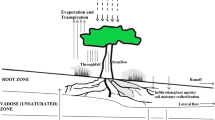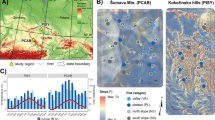Abstract
Oscillations of the air temperature and tensiometric pressure of the soil water were measured in the experimental slope Tomšovka (Czech Republic, Jizera Mts, 822 m a.s.l.). The brown forest soil (Dystric Cambisols) is covered with Calamagrostis villosa, Avenella flexuosa and Vaccinium myrtilus. Thermometers were placed at a height of 5 and 200 cm above the grassland. The tensiometer was installed in the root zone of grass at a depth of 15 cm. Oscillations in a cloudless day, August 24, 2001, (sunshine duration 12.1 hour/day, daily total of global radiation 22.4 MJ/m2/day, maximum intensity of global radiation 1008 W/m2, transpiration 13.7 MJ/m2/day) were analysed in detail. The oscillations with a period of about 30 to 60 minutes were recorded in the air temperature course taken from 11 am to 5 pm. At the height of 200 cm oscillations ranged from 24 to 28°C. Concurrently, in the depth of 15 cm, the oscillations of tensiometric pressure in the range of −6 to −11 kPa were recorded from 8 am to 4 pm. It was concluded that the oscillations in the air temperature resulted from autonomous and self-regulated oscillations in the intensity of transpiration. It is evident that the 2-m air temperature was significantly influenced by transpiration of plants around the large area. The fact that the air temperature oscillated sharply confirms that the rate of transpiration was synchronized in this area. Vegetative cover thus created a self-regulated superorganism that substantially affected the temperature of the near-ground atmosphere layer.
Similar content being viewed by others
References
Allen R.G., Pereira L.S., Raes D. & Smith M. 1998. Crop Evapotranspiration Guidelines for Computing Crop Water Requirements. FAO Irrigation and Drainage Paper 56, Food and Agriculture Organization of the United Nations, Rome, 300 pp.
Baluška F. (ed.) 2009. Plant-Environment Interactions: From Sensory Plant Biology to Active Plant Behavior. Springer-Verlag, Berlin Heidelberg, 318 pp.
Baluška F. (ed.) 2013. Long-Distance Systemic Signaling and Communication in Plants. Signaling and Communication in Plants, Vol. 19. Springer-Verlag, Berlin Heidelberg, 431 pp.
Baluška F. & Mancuso S. 2009. Plant neurobiology: from sensory biology, via plant communication, to social plant behavior. Cognitive Processing 10(Suppl. 1): 3–7
Baveye P.C. 2013. Addressing key challenges to interdisciplinary research on water-related issues: Biologists’ engagement and funding structure. Biologia 68: 1087–1088.
Cuevas J.G., Calvo M., Little C., Pino M. & Dassori P. 2010. Are diurnal fluctuations in streamflow real? J. Hydrol. Hydromech. 58: 149–162.
Gibert D., Le Mouël J.-L., Lambs L., Nicollin F. & Perrier F. 2006. Sap flow and daily electric potential variations in a tree trunk. Plant Sci. 171: 572–584.
Geiger R., Aron R.H. & Todhunter P. 2003. The climate near the ground. 6th edition. Rowman and Littlefield Publishers, Lanham, MD, USA, 602 pp.
Hrnčíř M., Šanda M., Kulasová A. & Císlerová M. 2010. Runoff formation in a small catchment at hillslope and catchment scales. Hydrol. Process. 24: 2248–2256.
Lichner Ľ., Holko L., Zhukova N., Schacht K., Rajkai K., Fodor N. & Sándor R. 2012. Plants and biological soil crust influence the hydrophysical parameters and water flow in an aeolian sandy soil. J. Hydrol. Hydromech. 60: 309–318.
Makarieva A.M. & Gorshkov V.G. 2007. Biotic pump of atmospheric moisture as driver of the hydrological cycle on land. Hydrol. Earth Syst. Sci. 11: 1013–1033.
Martinez-Lozano J.A., Tena F., Onrubia J.E. & Rubia J. 1984. The historical evolution of the Angstrom formula and its modification: review and bibliography. Agric. For. Meteorol. 33: 109–128.
Novák V. & Havrila J. 2006. Method to estimating the critical soil water content of limited availability for plants. Biologia 61(Suppl. 19): S289–S293.
Pokorny J. 2000. Dissipation of solar energy in landscape controlled by management of water and vegetation. Renew. Energ. 24: 1641–1645.
Pražák J., Šír M. & Tesař M. 1994. Estimation of plant transpiration from meteorological data under conditions of sufficient soil moisture. J. Hydrol. 162: 409–427.
Saito T., Tanaka T., Tanabe H., Matsumoto Y. & Morikawa Y. 2003. Variations in transpiration rate and leaf cell turgor maintenance in saplings of deciduous broad-leaved tree species common in cool temperate forests in Japan. Tree Physiol. 23: 59–66.
Szabó N., Tötzke C. & Tributsch H. 2008. Total internal reflectance-infrared structural studies on tensile water formation during evaporation from nanopores. J. Phys. Chem. C 112: 6313–6318.
Tesař M., Šír M., Lichner Ľ. & Čermák J. 2007. Plant transpiration and net entropy exchange on the Earth’s surface in a Czech watershed. Biologia 62(Suppl. 19): 547–551.
Tributsch H., Čermák J. & Nadezhdina N. 2005. Kinetic studies on tensile state of water in trees. J. Phys. Chem. B 109: 17693–17707.
Wallach R., Da-Costa N., Raviv M. & Moshelion M. 2010. Development of synchronized, autonomous and self-regulated oscillations in transpiration rate of tomato whole plant under water stress. J. Exp. Bot. 61: 3439–3449.
WRB 2006. World Reference Base for Soil Resources 2006. World Soil Resources Reports No. 103. FAO, Rome 128 pp.
Author information
Authors and Affiliations
Corresponding author
Rights and permissions
About this article
Cite this article
Šír, M., Tesař, M., Lichner, Ľ. et al. The effect of grass transpiration on the air temperature. Biologia 69, 1570–1576 (2014). https://doi.org/10.2478/s11756-014-0469-2
Received:
Accepted:
Published:
Issue Date:
DOI: https://doi.org/10.2478/s11756-014-0469-2




